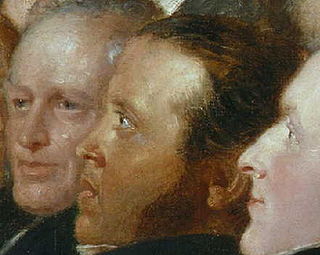
Baptists form a major branch of Protestantism distinguished by baptizing professing Christian believers only, and doing so by complete immersion. Baptist churches also generally subscribe to the doctrines of soul competency, sola fide, sola scriptura and congregationalist church government. Baptists generally recognize two ordinances: baptism and communion.

Accompong is a historical Maroon village located in the hills of St. Elizabeth Parish on the island of Jamaica. It is located in Cockpit Country, where Jamaican Maroons and indigenous Taíno established a fortified stronghold in the hilly terrain in the 17th century. They defended it and maintained independence from the Spanish and then later the British, after the colony changed hands.

Saint Catherine is a parish in the south east of Jamaica. It is located in the county of Middlesex, and is one of the island's largest and most economically valued parishes because of its many resources. It includes the first capital of Jamaica, Spanish Town, originally known as San Jago de la Vega or Santiago de la Vega.

Saint Elizabeth, one of Jamaica's largest parishes, is located in the southwest of the island, in the county of Cornwall. Its capital, Black River, is located at the mouth of the Black River, the widest on the island.

Trelawny is a parish in the county of Cornwall in northwest Jamaica. Its capital is Falmouth. It is bordered by the parishes of Saint Ann in the east, Saint James in the west, and Saint Elizabeth and Manchester in the south. Trelawny is known for producing several Olympic sprinters.

Kingston Harbour in Jamaica is the seventh-largest natural harbour in the world. It is an almost landlocked area of water approximately 16 kilometres (9.9 mi) long by 3.2 kilometres (2.0 mi) wide. Most of it is deep enough to accommodate large ships, even close to shore. It is bordered to the north by the city of Kingston, the capital of Jamaica; to the west by Hunts Bay and the municipality of Portmore; and to the south and east by the Palisadoes strip, which protects it.

Discovery Bay is a town in Saint Ann Parish on the northern coast of Jamaica. The city is also known locally as Dry Harbour, and gives its name to the Dry Harbour Mountains in St. Ann. There is a dispute as to whether Christopher Columbus first landed in Discovery Bay or Sevilla la Nueva in 1494. Near to the city are Puerto Seco Beach and several historic sites, such as the Green Grotto Caves and Columbus Park. Visitors to the Green Grotto Caves can see relics of the native Taíno Arawak lifestyle there. It is said that many Spaniards escaped the English invasion of 1655 through secret passages in the caves with the help of Arawaks and African slaves, in exchange for the slaves' freedom.

William Knibb, OM was an English Baptist minister and missionary to Jamaica. He is chiefly known today for his work to free enslaved Africans.

George Liele was an African American and emancipated slave who became the founding pastor of First Bryan Baptist Church and First African Baptist Church, in Savannah, Georgia (USA). He later would become a missionary to Jamaica.

Thomas Burchell (1799–1846) was a leading Baptist missionary and slavery abolitionist in Montego Bay, Jamaica in the early nineteenth century. He was among an early group of missionaries who went out from London in response to a request from African Baptists on the island. He established churches and schools to aid the slaves. Burchell is credited with the concept of Free Villages and encouraging their development by Baptist colleagues such as William Knibb, as well as by other denominations. Anticipating abolition of slavery, he helped raise funds in Great Britain to acquire land for freedmen after they were emancipated, and to develop Free Villages.

Calabar High School is an all-male secondary school in Kingston, Jamaica. It was established by the Jamaica Baptist Union in 1912 for the children of Baptist ministers. It was named after the Kalabari Kingdom later anglicized by the British to Calabar, in present-day Nigeria. It has produced at least five Rhodes Scholars, and is respected for its outstanding performance in track and field.
Jamaican Maroons descend from Africans who freed themselves from slavery on the Colony of Jamaica and established communities of free black people in the island's mountainous interior, primarily in the eastern parishes. Africans who were enslaved during Spanish rule over Jamaica (1493–1655) may have been the first to develop such refugee communities.
The Jamaica Province of the Moravian Church is part of the worldwide Moravian Church Unity.
Jamaica's laws establish freedom of religion and prohibit religious discrimination. According to the census of 2011, 69% of the population are Christians of various denominations, while 21% stated they had no religion.
The Port Authority of Jamaica (PAJ) is an agency of the Ministry of Transport and Mining responsible for the:
Maroon Town is a settlement in Jamaica. It has a population of 3122 as of 2009.

Saint Ann's Bay is a settlement in Jamaica, the capital of Saint Ann Parish. It had a population of 10,961 at the 1991 census.

Christianity was introduced by Spanish settlers who arrived in Jamaica in 1509. Thus, Roman Catholicism was the first Christian denomination to be established. Later, Protestant missions were very active, especially the Baptists, and played a key role in the abolition of slavery.
The Jamaica Baptist Union is a Baptist Christian denomination, affiliated with the Baptist World Alliance, founded in 1849 in Jamaica. The headquarters is in Kingston, Jamaica. The president of the union is Rev. Dr. Glenroy Lalor.

The Church of Jesus Christ of Latter-day Saints in Jamaica refers to the Church of Jesus Christ of Latter-day Saints and its members in Jamaica. In 1980, there were 85 members in Jamaica. In 2021, there were 6,718 members in 18 congregations.














